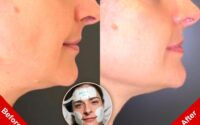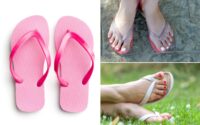3D scan reveals how high heels can leave your feet disfigured
Like so many women, I do love my high heels.
I adore how they give me an extra three inches of height, making me look leaner and longer.
With a fabulous pair of stilettos I feel ready to take on the world.
In lockdown, I traded my heels for comfy slippers and socks. But as we move back towards normal, my heels are making a return.
Stars stepping out in towering heels at this week’s Paris Fashion Week included designer Victoria Beckham, 47; actress Anya Taylor-Joy, 25; supermodel Naomi Campbell, 51; and even the heavily pregnant singer Rihanna, 34.
It was recently reported that Sarah Jessica Parker, 56, declined to kick off her heels during long, 14-hour days while filming her Sex And The City spin-off And Just Like That.
Many of us think it is par for the course when it comes to looking stylish — though teetering around on your tiptoes is hardly known for being comfortable.
But what are stilettos really doing to our health? I became the first journalist to try a 3D scanner at the London Foot and Ankle Centre at the capital’s London Bridge Hospital.
This involves taking a 360-degree view of the inside of my foot while I am wearing my favorite pair of heels, black pointy-toed stilettos with a four-inch heel.
It takes hundreds of images from different angles showing how the structure of my feet is altered by my wearing heels.

For the scan, all I had to do was step into the middle of the knee-high machine that looks like a giant foot bath. I stood still as a fixed camera whirred around me. Until now, I have always thought my shoes looked elegant.
But when consultant surgeon Martin Klinke showed me the images, I realized it was not such a pretty sight on the inside.
The first thing that struck me is how my shoes force my feet into an unnatural position.

I thought they fitted my size-sevens perfectly. So I was shocked to see how they make my toes claw up.
All are now bent at the joint, making the front of my foot look like a giant spider on the loose.
Mr. Klinke said: “With high heels that have narrow points, the toes not only get squashed, they get clawed too.
“The toe joints are forced to an angle of up to 90 degrees.”
If you wear high heels a lot, this can lead to “hammer toe” whereby the joints get stuck and the tendons contract and tighten, making toes look permanently bent.
My shoes are also forcing my big toe inwards, exposing the joint at the bottom and making it stick out. Over time, these could develop into bony bumps, or bunions, especially if I already have a genetic predisposition to them.
The scan showed how my high heels are making my feet less stable by changing the angle of my metatarsals — the five long bones in the foot — from 20 degrees to an unhealthy 80.
While a one-inch heel has been estimated to put 22 percent more pressure on the ball of your foot than a flat shoe, wearing three-inch heels will send that soaring by 75 percent.
Mr Klinke said: “There is so much pressure going down into the small part of your forefoot.
I adore how they give me an extra three inches of height, making me look leaner and longer. With a fabulous pair of stilettos I feel ready to take on the world.
Tanith Carey
“This causes tightness of the calf muscle and then, when wearing ‘normal’ flat shoes, this will lead to an overload — and pain in the balls of your feet.”
So do I have to give up my beloved high heels for the sake of my foot health?
Mr. Klinke says: “It’s fine to wear them for an event or a party but not really a good idea to wear them on a daily basis. Wearing a bit of a heel — an inch, say — is fine but it’s better if it’s a broader, more stable type with a wider toe box that doesn’t crowd the toes so much.”
I won’t be giving them up completely — but I WILL be saving my killer heels for special events while keeping a pair of emergency flats in my bag.
Here are some of the risks of wearing high heels:
- FOOT PAIN: Big heels shift your body weight forward, onto the balls of your feet. This puts strain on your metatarsals. There are also two pea-shaped bones just below the base of each big toe which help the foot push off on each step. Wearing heels can inflame the nerves and tissues around these bones and cause shooting pains in your foot, a condition known as metatarsalgia. Fibrous tissue can grow around the nerves, usually between the third and fourth toe. Called Morton’s neuroma, it feels like having a pebble in your shoe.
- TIGHT CALVES: Over time, walking with your feet elevated can make muscle fibres shorten and thicken. So when you wear flats, your calves feel taut and uncomfortable.
- BUNIONS: These develop when your feet are often squeezed into narrow, pointed-toe footwear. The joint at the base of the big toe juts out making walking difficult.
- HAMMER TOES: When you stand on high heels, the weight of your body pushes down into the end of the shoe, forcing the toes to bend up and claw. Over time, the tendons in these toes can shorten and the joints become rigid. You can’t straighten them even when you take off your heels.
- ANKLE INJURY: Changing your centre of gravity can make your ankles unsteady and less flexible. The higher the heel, the bigger the risk of losing balance and rolling onto the outside of the foot. This may stretch ankle ligaments. A tumble when wearing high heels is more likely to tear those ligaments or even break bones.
- CORNS AND CALLUSES: When your foot is forced into an unnatural position, you are more likely to form thick, hardened layers of skin where shoes rub against your foot.
- INGROWN TOENAILS: High heels tend to jam your toes close together into the end of the shoe. Meeting this resistance can make toenails thicken or grow into the skin.
- PLANTAR FASCIITIS: The way high heels tighten calf muscles can have a knock-on effect on your plantar fascia, the thick band of connective tissue that runs along the bottom of each foot to your heel. This layer can get torn or inflamed, with painful consequences.
This story originally appeared on The Sun and has been reproduced here with permission.


